|
WEB GRAFFITI ZINE Zine 20v10: 19th Century Articles Reprinted for research reference Collated by William Hillman Assistant Professor ~ Faculty of Education ~ Brandon University
|
|
WEB GRAFFITI ZINE Zine 20v10: 19th Century Articles Reprinted for research reference Collated by William Hillman Assistant Professor ~ Faculty of Education ~ Brandon University
|
![]()
Harper's Weekly Magazine gave a lot of attention to the Plains Indians during the years immediately after the Civil War.
As you can read in the three articles directly below, the magazine's editorial discussion of the nation's policy toward the Native Americans took a relevatively balanced attitude, arguing for justice as well as firmness and acknowledging the role of white aggression and bad faith as a cause of Indian hostilities.
But Harper's Weekly was best-known for its illustrations, and during this period its visual representations of Indians are strikingly partisan, depicting the Indians as savage predators ruthlessly stalking and attacking white victims -- as you can see for yourself in the images below."Our Indian Policy" (March 1867) OUR INDIAN POLICY
"What Should Be Done with the Indians?" (August 1867)
"A Home Question" (July 1870)
"Our Barbarian Brethren" 30 April 1870
"Late Indian Outrages" 27 July 1866
Harper's Weekly Magazine ~ 9 March 1867
That our whole Indian policy must be reviewed and improved there is no longer any doubt. The Secretary of War informs the Military Committee that the Indian traders are freely selling muskets and ammunition to the Indians, who, by the exorbitant prices they pay, are manifestly preparing for hostilities. Lieutenant-General Sherman has forbidden any further transactions of the kind, and General Grant has approved his prohibition, saying that if we are to go on arming the Indians we must either withdraw our troops, and Congress must authorize a general Indian war, or the whites upon the great Plains must be exterminated.The frontier whites are doubtless responsible for much of this trouble. The mutual hostility of the whites and the Indians is most bitter. The horrible massacre by the Indians of the garrison of Fort Kearney shows how relentless the enmity is, and it is difficult to see what remedy there is but the presence of a large and imposing military force upon the Plains and the sternest punishment for such offenses. The difficulty is constantly increased by the jealousies among the Indians in regard to the money which it is the duty of the Secretary of the Interior to spend for their benefit. General Grant is of opinion that the exigency demands the transfer of the Indian Bureau to the War Department, and the abolition of the system of Indian agents and licensed traders.
It is evident that the present Indian management is inefficient. As the Pacific Railroad is pushed across the Plains, and the question of rapid intercourse with the western shore of the continent rises into importance, the question of its security is not less vital. The country which the Indians occupy is not arable. Their reliance is the chase; and when the buffalo is scarce they must depend upon the plunder of emigrant trains. The whole subject has been postponed and laid aside. But we trust that the reports of the Secretary of War to the Military Committee, with the testimony of Generals Grant and Sherman, will lead to a comprehensive and careful consideration of the matter.
It should be constantly remembered, however, that the whites are equally guilty with the Indians; and the new system should comprehend the strictest supervision of the whites with the utmost possible protection of the Indians. Any policy which encourages the whites to regard the Indians as mere vermin to be shot at sight, which is substantially the present policy, will only teach the Indians to retaliate. We have no sentimental theory of the Indians, but a system of simple extermination will cost us as dearly as it costs them. The frontiers must be made secure; but if the savages could feel that we were not necessarily their enemies we should have taught them what our treaties have hitherto failed to teach.
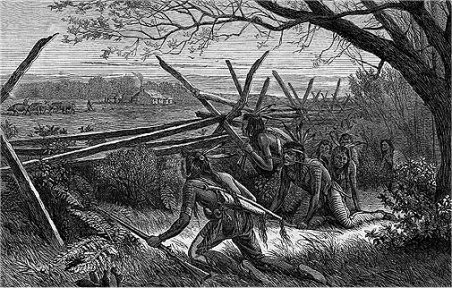
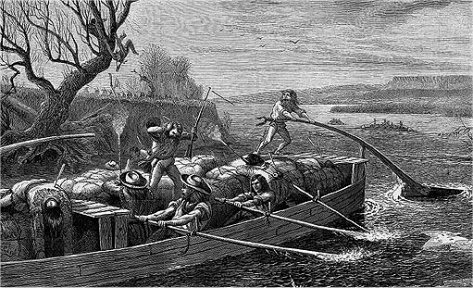
Fur traders on the Missouri attacked by Indians
WHAT SHOULD BE DONE WITH THE INDIANS?
Harper's Weekly Magazine ~ 17 August 1867
Certainly the country has reason to be dissatisfied with the present conduct of the Indian war on the plains. It was begun by volunteer troops of the United States in 1864 by the commission of a series of outrages culminating in the horrible "Chivington massacre." It has been characterized in its progress since only by ambuscades and massacres of the white settlers, travelers, and troops. The great industrial enterprise of the age, the Pacific Railroad, has been retarded--it is now, as far as one branch is concerned, abandoned; the overland routes to the Pacific coast have been interrupted, and, practically, travel is at this time suspended. Fights, in which our troops are invariably at the disadvantage of inadequate numbers of men and animals, are of almost daily occurrence; and disasters to our arms or massacres of our settlers have been recorded and illustrated in this journal for the last ten months with painful frequency. Nothing, literally nothing, has been accomplished by the commands of Generals Hancock and Custer in their seemingly purposeless marches to and fro between the Platte and Arkansas rivers; the Indians, in small but decidedly predatory bands, control the whole region between those streams and along the Kansas and Colorado border. And yet we are officially told that this ineffective style of warfare is costing the country $1,000,000 per day, and it was estimated a month ago that $100,000,000 would be expended in accomplishing the work of subduing about ten or fifteen thousand warriors spread over a territory of only about two hundred miles square. At the present rate of progress it will certainly cost that much.But is there not a cheaper, wiser, and more humane method of dealing with these refractory subjects? Is it imperatively necessary that the country should prosecute the war to the "lame and impotent conclusion" which it threatens? What has become of the mysterious Indian Peace Commissioners lately mentioned as at Washington ready to proceed to the scene of warfare? If such a Commission is not on its way to the West one should be sent immediately, and the war terminated at once. If we were right in beginning it we are powerful enough to afford to be generous in granting terms of peace; if we were at fault--and there remains but little doubt of that--we ought to be for that reason more eager to conclude a liberal peace. It is very clearly understood that this, like all the previous Indian wars in the West, originated in disputes between the Indians and white settlers--that it is the natural contest arising out of the clashing of the adverse interests of the two races located on and each claiming the territory; and the surest way to settle this and prevent all similar wars, is for the Government to take its proper position as an arbiter between its sons and its dependents, and see that the latter have mercy shown them. It is not justice but mercy that the Government is called upon to exercise, for justice to the poor, contemptible, and degraded Indian would be severest cruelty. The Indian tribes, as regards numbers and nature, are in a dependent state; they prefer that idle and ignoble condition, and can be just as well, and much more cheaply, taken care of as our pensioners than as our antagonists. In every treaty which has been made with them for years past they have easily been induced to abandon their old homes for new reservations away from the white man's track; and there is nothing to prevent a sensible commission, properly authorized, from inducing all the belligerent tribes occupying the envied and contested ground between the Platte and Arkansas rivers to remove to more remote hunting-grounds by the judicious expenditure of a few millions in trinkets and annuities.
A HOME QUESTION
Harper's Weekly Magazine ~ 23 July 1870
The Indian difficulty seems to be almost hopeless. Two influential chiefs have just been at Washington and New York, seeking to come to some understanding. They are scarcely back again upon the plains--the Red Cloud has hardly vanished--when the black cloud rolls up, and we are told that we are to have a war. If it be a general war it will be a terrible war; a war full of atrocities and involving enormous expense; and when there comes a lull called peace we shall find that the only result is an immense increase of the debt and a slight decrease of the Indian population. It is not very easy to discover what the exact understanding was between the Government and Red Cloud. His complaint, however rhetorically served up in the reports, was very distinct. It was the old story of bad faith. "You are the strong power," he says. "You ask us to make a treaty. We make it, and you break it." And that is undoubtedly the truth. Yet it must be allowed that the Indians are a wild and impracticable race; that contact with civilization corrupts them; and that, if we break treaties, they are also treacherous and ferocious. We must deal with facts, not with theories nor hopes nor wishes. It can not be honestly said, for instance, that the approach of the white race and civilzation have made the Indian cruel. They found him so.Shall they, then, be exterminated? If the bare suggestion be denounced as infamous, it is evident that we must do something else than fight them perpetually. But if we find that we can not manage them from without, can we not manage them from within? If, for instance, Red Cloud and others be really chiefs of influence, why not make them directly serviceable? Why not prove to them the generous intention of the Government, show them its willingness to atone liberally for injuries, explain to them the difficulties which necessarily surround the subject, persuade them that it is not hostile but friendly, and so win the leaders who command the tribes? Macaulay, in his essay upon "Ranke's History," says that the administrative genius of the Roman Church shows itself conspicuously in turning to account every kind of material, every whim and prejudice and fanaticism and passion. Instead of allowing the discontented or the zealous to withdraw as sects, it organizes them as orders. Loyola, at Oxford, would have headed a secession; John Wesley, at Rome, would have been made general of a new society in the Church.
The principle is as wise in the government of a country as in that of a Church. Is it wholly impracticable in our Indian policy? Is it impossible for us to prove to Red Cloud and his brethren that their highest interest lies in friendly relations with us, relations that we will honestly maintain? If, indeed, mutual intelligence is impossible--if Red Cloud is a mere grizzly bear, and it would be as reasonable to attempt relations with the buffaloes as with the Indians, which seems to be the theory of some, let us act accordingly. There is no prohibition upon hunting the buffalo. Every hunter rides and shoots at his own risk. We propose no buffalo treaties; we have no buffalo reservations. If the Indians are mere horned beasts, the only care we need have is to prevent them from goring the frontier. But if they are not buffaloes we must act differently. If we make treaties with them, we must insist that they be observed. The Chinese question excites Congress to that degree that it loses its temper and bandies unhandsome epithets in the freest manner. Is there nobody in Congress from the West familiar with the details of the Indian question who is interested enough to propose an honorable and feasible policy?
OUR BARBARIAN BRETHREN Indian Lodge - Scene of Indian Peace Council

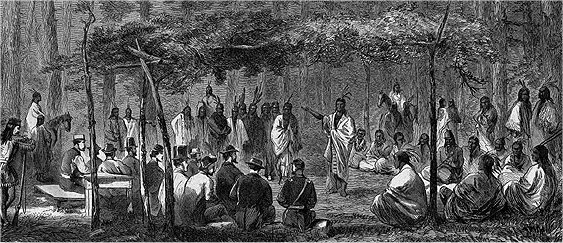
Council with Kiowa and Comanche Indians
Harper's Weekly Magazine ~ 30 April 1870
Our Indian fellow-citizens, it is well known, entertain very lax notions respecting the sanctity of the marriage tie--which, in fact, they consider any thing but a tie. The noble red man not only regards his wives as inferiors, but in the light of goods and chattels, and when tired of them trades them off in barter, or swaps them for another's. Our illustration on this page is an accurate sketch of the kind of trade that frequently takes place among them--an old, homely wife swapped for a young and pretty one, and a horse thrown in to boot. The women submit, knowing very well that they can't help themselves.Our second illustration on this page records a very curious incident that took place recently at Fort Shaw, Montana. The Piegan Indians, being about to sue for peace, as a preliminary step, killed "Pete," one of the principal murderers of white settlers in that region, and brought his head to General De Trobriand as a pledge of their sincerity. The face of the dead "brave," deeply pitted with small-pox and scarred with wounds, presented a ghastly spectacle when uncovered in the General's presence; but as a token of their desire to cultivate more friendly relations with the whites it was more eloquent than words.
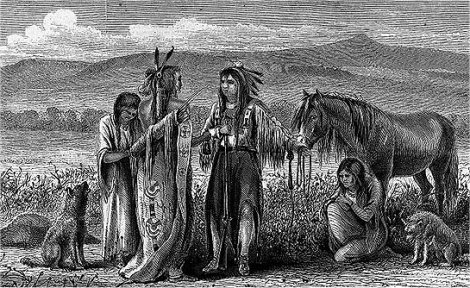
Indians Swapping Wives |
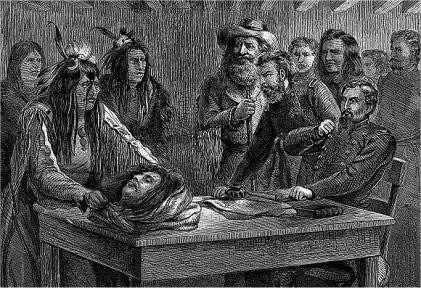
An Indian Peace-Offering |
LATE INDIAN OUTRAGES
Harper's Weekly Magazine ~ 27 July 1866
The war on the "Smoky Hill Route" through Kansas
continues with great fury. On the 26th of June last a band of three hundred
Cheyennes, under a chief called "Roman Nose," attacked a station two miles
from Fort Wallace, and ran off the Overland Stage Company's stock. They
then advanced toward the fort, when Company G of the Seventh United States
Cavalry, under command of Captain Barnitz, went out of meet them. The Indians
fell back to the brow of a hill two miles from the fort, then turned and
awaited the attack. The cavalry charged at a gallop, and were met by a
counter charge. The Indians, with lances poised and arrows on the string,
rode at them with great speed, and a hand-to-hand fight followed, in which
the savages displayed unlooked-for daring. With their overwhelming numbers
they succeeded in driving the cavalry back to the fort, with a loss of
seven men killed, several wounded, and half the horses captured or killed.
"Roman Nose" was very conspicuous in the fight, dashing into the midst
of the fray on his powerful gray horse. He carried a spear, with which
he unhorsed a soldier, and was about to spear him as he lay on the ground,
when Corporal Harris struck the savage with his sword, which he had in
his left hand. "Roman Nose" turned upon him, but as he did so Harris placed
the muzzle of the Spencer rifle which he carried in his right hand at the
breast of the savage and fired. With the blood spouting from his wound
the Indian fell forward on his horse.
The Indians committed unheard of atrocities. A powerful warrior was seen to pick up the bugler, Charles Clark, who had been pierced by three arrows, and strip him as he rode along; after taking off all his clothing he mashed the head to a jelly with his tomahawk, and then threw the body under his horse's feet. The body of Sergeant Frederick Wyllyams was also fearfully mutilated. His scalp was taken, two balls pierced his brain, and his right brow was cut open with a hatchet. His nose was severed and his throat gashed. The body was opened and the heart laid bare. The legs were cut to the bone, and the arms hacked with knives. We give an engraving of the body from a photograph. We also give an illustration of the fight and a view of Fort Wallace, near which the engagement occurred. They are from sketches by Major A. R. Calhoun and Dr. Bell, who are associated with General Wright, now en route to make surveys in New Mexico, Arizona, and California for the Union Pacific Railroad. Major Calhoun describes Fort Wallace as being beautifully located on the North Fork of the Smoky River. Buildings are being erected of a beautiful pink-colored magnesian limestone, which can be cut with a saw and plane, and hardens on exposure.
Our other illustrations refer to an outrage perpetrated
on Plum Creek, 14 miles west of Fort Harker, on June 16, in which two men
named Carley and Doherty were attacked. A band of Indians approached and
shook hands with them, and the next moment fired upon them. Carley was
mortally wounded, but managed, with Doherty's aid, to get into the hut,
where they fought the Indians for some hours, and finally drove them off.
When they were gone Doherty swam Smoky Hill River, and going to the town
of Ellsworth, gave the alarm. A party was sent in a boat to Carley's assistance,
but he was dead. The body was taken to Ellsworth, and there buried.
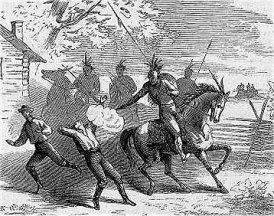
Attack of the Indians on Carley and Doherty |
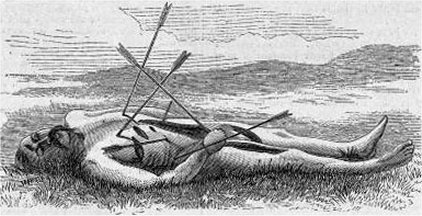
Body of Sergeant Wyllyams |
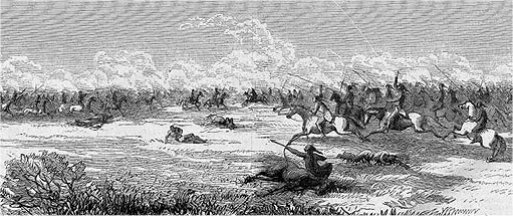
Desperate battle between the Cheyenne and Company
G Seventh US Cavalry
near Fort Wallace, June 26, 1867
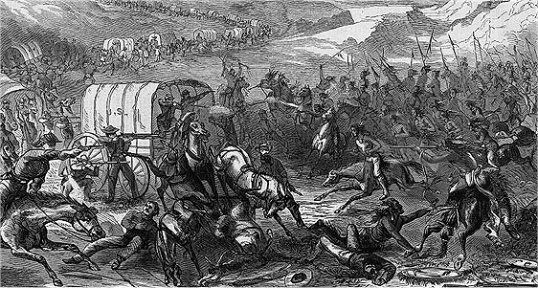
The Indian War - Indians attacking a wagon train
Textualizing the Native Americans
c1800: about 600,000 Native Americans (Indians) live in North America
1863: The Long Walk--U.S. Army unit led by Kit Carson forces over 8000
Navajo and Mescalero Apache from their native lands to New Mexico
1864: Sand Creek Massacre--as many as 500 peaceful Cheyenne men, women
and children killed in an attack by Colorado militiamen
1865: Sioux-Cheyenne uprising--attacks by warriors around Forts Rankin,
Mitchell and Laramie
1866-1868: War for the Bozeman Trail--fought between the Army and Sioux
led by Red Cloud over treaty-violating attempts to give gold-seekers access
to Western Montana
1867 & 1868: Treaties of Medicine Lodge Creek and Fort Laramie--U.S.
pledges to protect and supply Indians who accept re-settlement to designated
reservations
1868-1869: fighting continues across the Great Plains as militant Indians
raid settlements and Army units destroy villages
1870: according to U.S. Census, 313,000 Indians live in North America
1871: Congress passes a law stating the U.S. will no longer negotiate
with Indians as "nations"
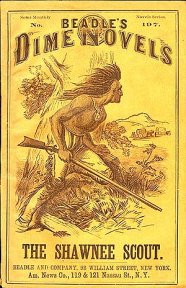
10
Beadle's Dime Novel Covers (1860 - 1873)
Erastus Beadle began publishing inexpensive, short, paperback novels
in 1860.
None of these action tales are set in "the West" or even in the second
half of the 19th century; all are historical fictions featuring the Eastern
tribes that were essentially gone by the 1860s. Yet these covers almost
certainly mirrored and helped shape popular ideas of the "Indians" who
remained very much alive in the west and in the collective white consciousness.
Greeley:
An Overland Journey (1860)
From An Overland Journey,
from New York to San Francisco, in the Summer of 1859
By Horace Greeley
New York: C. M. Saxton, Barker and Co., 1860
From Letter 13: "Lo! the Poor Indian!"
Marcy: The Prairie Traveller (1863)
Bowles: Across the Continent (1866)
Harper's Weekly Magazine (1866-70)
Richardson: Beyond the Mississippi (1867)
Browne: Adventures in the Apache Country (1868)
Child: An Appeal for the Indians (1868)
Keim: Sheridan's Troopers on the Borders (1870)
Bell: New Tracks in North America (1870)
Brisbin (ed.): Belden, The White Chief (1870)
Logan: "Does Visiting Yosemite Pay?" (1870)
Wood: The Uncivilized Races of Men (1872)
Webb: Buffalo Land (1872)
Greenwood: New Life in New Lands (1873)
Beadle: The Undeveloped West (1873)
A Montana Flathead Indian Speaks (1876)
Winnemucca: Life among the Piutes (1883)
Saskatchewan Indian:
A collection of selected full text articles, 1970 - 2003
Pukatawagan: Reflections of a Wimistikosiw Visitor
![]()
WEBZINE
ARCHIVE
Hillman
Eclectic Studio
All Original Work ©2009/2014 by Bill Hillman and/or Contributing Authors/Owners